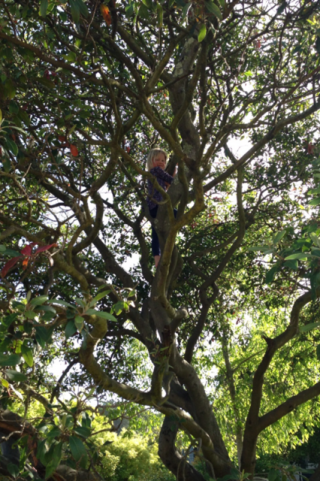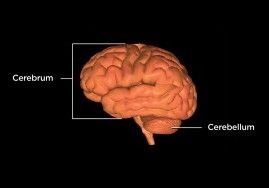Anxiety
Science Confirms Why "Oh, the Places You'll Go!" Is Genius
New studies reveal that children need both autonomy and a sense of adventure.
Posted May 1, 2013

"Oh, the Places You'll Go!" in Action
You've got brains in your head. You've got feet in your shoes. You can steer yourself any direction you choose. –Dr. Seuss
My 5-year old daughter loves to climb very tall trees. Can you find her hidden among the branches in this image? As a parent, it can be nerve racking to watch her climb fearlessly to dangerous heights. She takes autonomy and the adventurous spirit of her favorite book – “Oh, the Places You’ll Go!” – to a terrifying level. Which is a good thing, and a bad thing.
Letting go of the reins enough to allow her freedom to soar—while making sure she's safe—is always a high wire balancing act. Her boldness can cause parental anxiety, but one doesn't want to be a panicky 'helicopter' parent, either. Every parent struggles with this dilemma. But studies confirm that it's important to follow the advice of Dr. Seuss, and not be overprotective.
Helicopter Parenting Can Backfire
Researchers have found that being an overprotective 'helicopter' parent may put children at risk and stunt healthy development. On April 25, 2013 researchers at University of Warwick published a study titled “Poor parenting -- including overprotection -- increases bullying risk”
Professor Dieter Wolke, lead researcher of the study, highlighted the finding that overprotection was linked to an increased risk of bullying saying,
“Although parental involvement, support and high supervision decrease the chances of children being involved in bullying, for victims overprotection increased this risk. Children need support but some parents try to buffer their children from all negative experiences. In the process, they prevent their children from learning ways of dealing with bullies and make them more vulnerable. It could be that children with overprotective parents may not develop qualities such as autonomy and assertion and therefore may be easy targets for bullies.”
Another study titled, "Children Who Avoid Scary Situations Likelier to Have Anxiety" was released by the Mayo Clinic on March 11, 2013. One of the most surprising findings from this study was that measuring avoidance could also predict children's development of anxiety.
Most children experience fears of one kind or another, but for some children those fears become heightened as part of an anxiety disorder. When children begin to avoid scary situations, anxiety disorders can become particularly disabling, preventing participation in everyday activities.
Stephen Whiteside, a pediatric psychologist and lead researcher of the Mayo clinic study, found that after following cognitive behavior therapy that slowly exposed anxious children to the situations that caused fear, the avoidance scores from surveys of their parents declined by half.
This likely indicates that part of the reason they're getting better is that they're no longer avoiding things, Dr. Whiteside says. Adding, "Even after controlling for their baseline anxiety, those who avoided had more anxiety than kids who didn't avoid.”
The Neuroscience of “Oh, The Places You’ll Go!”
Dr. Seuss is brilliant in giving advice that flexes both the cerebrum and the cerebellum of a healthy child’s developing brain. Scientists have confirmed that being exposed to novel and enriched environments bulks up the neocortex of the cerebrum, which leads to higher brain function.

Cerebrum "Up Brain" | Cerebellum "Down Brain"
Also, the cerebellum—which keeps track of balance, fine-tuned motor skills and proprioception—becomes stronger and more finely tuned when used regularly and learns through practice. Both the cerebrum and the cerebellum have a left and right hemisphere that will lose brain mass if not engaged regularly through intellectual, creative, and physical exploration.
Living a sedentary life and experiencing the world through a two-dimensional digital screen causes two of your brain’s four hemispheres to atrophy. Literally one-half of your brain lays dormant and underutilized if it is not engaged through daily physical activity and curious exploration through the three-dimensional world around us and face-to-face interactions with people.
This is especially important for our children, which is why the message of "Oh, the Places You'll Go!" is especially important in the 21st century. The consistent engagement of all hemispheres of the brain is crucial for the mental and physical well being of all generations, especially in a digital age where we are prone to the ‘future shock' of living a two-dimensional life through a computer interface.
When Dr. Seuss says, “So be sure when you step. Step with care and great tact and remember that Life’s a Great Balancing Act. Just never forget to be dexterous and deft. And never mix up your left foot with your left.” He is actually giving advanced hints on the difference between the left and right hemispheres of both your cerebrum and cerebellum that scientists are just beginning to understand.
(Note: For more information on these topics, click on the embedded links above which will take you to previous Psychology Today blogs I’ve posted on these neuroscience topics.)
Conclusion
One reason I don't get clingy when my daughter climbs tall trees is that she's been exploring the world and exposed to enriched environments since infancy. She's built up gradually to higher levels of challenge as her skills develop. This is key.
By using common sense, trusting your gut, and finding the balance between being an overprotective parent and letting your children run wild, each child will develop a healthy sense of autonomy and a spirit of adventure that fits his or her individual personality.
And will you succeed? Yes! You will, indeed! (98 and 3 / 4 percent guaranteed.) –Dr Seuss




